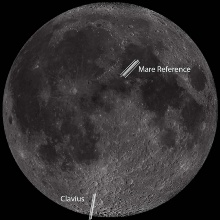For the first time, the SOFIA (Stratospheric Observatory for Infrared Astronomy) flying observatory has provided direct and unambiguous evidence of water molecules on the moon beyond the permanent shadow at the poles. The infrared observatory, which is owned jointly by the US space agency NASA and the German Aerospace Center (DLR) was able to detect the molecules in the moon’s southern hemisphere using the FORCAST (Faint Object InfraRed CAmera for the SOFIA-Telescope) instrument. The research results were published on the 26th of October 2020 in the scientific journal Nature Astronomy. On the German side, the scientific operation of SOFIA is coordinated by the University of Stuttgart’s German SOFIA Institute (DSI).
Scientists have been searching for unequivocal proof of water on the moon ever since the Apollo 11 mission brought the first lunar rocks back to Earth in 1969. These samples, however, as well as those recovered in the numerous follow-up missions, showed no clear evidence for the existence of water on the Earth's satellite. Only in 2009 was final confirmation found by NASA’s Moon Mineralogy Mapper on board the Indian Chandrayaan-1 mission, and only at the regions surrounding the moon’s poles. "Using SOFIA,” explains Bernhard Schulz, SOFIA Science Mission Operation Deputy Director at the University of Stuttgart, “we’ve finally succeeded in providing the long hoped-for clear proof that water also occurs in the warmer areas of the lunar surface illuminated by the sun." A team led by Casey Honniball of the Hawaiʻi Institute of Geophysics and Planetology had already used the FORCAST instrument on board SOFIA to make observations of the moon on the 30th of August 2018. The scientist was able to detect the unique fingerprint of molecular water in the mid-infrared range (six micrometers wavelength) around the Clavius crater in the moon’s southern hemisphere.
How does water come to be on the moon?
The sunlit areas of the moon reach temperatures of around 230 degrees Celsius at which temperature water is gaseous and ought to evaporate, as the moon has virtually no atmosphere. Yet it is present on the surface. There are currently two theories that may explain this: the impact force of micrometeorites striking the lunar surface and carrying small amounts of water might deposit it in the rock leaving it trapped in the ground in tiny glass-bead-like structures. However, a two-stage process may also be possible in which hydrogen is delivered to the lunar surface by the solar wind, where it combines with hydroxyl (HO) – a hydrogen atom bonded to an oxygen atom – thus forming water, which could seep into the surface where it would be protected from the sunlight.
Water as a basis for future space missions
One of the objectives of European space research, a large part of which is co-financed by Germany, is to confirm the presence of resources such as water on the moon in sufficient quantities to be able to use them for such things as a future "moon village". The quantity of water discovered by SOFIA is roughly equivalent to the contents of a 0.33 liter drink can, distributed in one cubic meter of soil. "This,” as Reinhold Ewald, European astronaut and professor at the University of Stuttgart’s Institute of Space Systems (IRS), explains, “is indeed less than in our terrestrial deserts. However, novel life-support systems, such as those we are developing and researching at the Astronautics and Space Stations research department at the IRS, could produce some of the resources we’ll need for future manned space missions.”
SOFIA will make more observations of the sunlit areas during different lunar phases to study the phenomenon of lunar water in more detail. The researchers are hoping that this will provide new insights into how water is produced and stored, as well as how it is distributed across the lunar surface. This data will be useful for planning future moon missions.
About SOFIA
SOFIA, the “Stratospheric Observatory for Infrared Astronomy”, is a joint project between the German Aerospace Center (DLR) and the American National Aeronautics and Space Administration (NASA). It is run by the DLR and funded by the German Federal Ministry for Economic Affairs and Energy (BMWi), the State of Baden-Württemberg and the University of Stuttgart. Scientific operations are coordinated by the German SOFIA Institute at the University of Stuttgart on the German side and the Universities Space Research Association (USRA) on the American side.
More SOFIA links
Expert Contact:
Prof. Dr. Alfred Krabbe, Deutsches SOFIA Institut am Institut für Raumfahrtsysteme der Universität Stuttgart, Tel.: +49 711 685-62406, E-Mail
Casey I. Honniball (Autorin), Ph.D., NASA Post-Doctoral Program Fellow, NASA Goddard Space Flight Center, E-Mail
Molecular water detected on the sunlit Moon by SOFIA, C.I.Honniball et al. Nature Astronomy, 26. 10. 2020, DOI: 10.1038/s41550-020-01222-x


